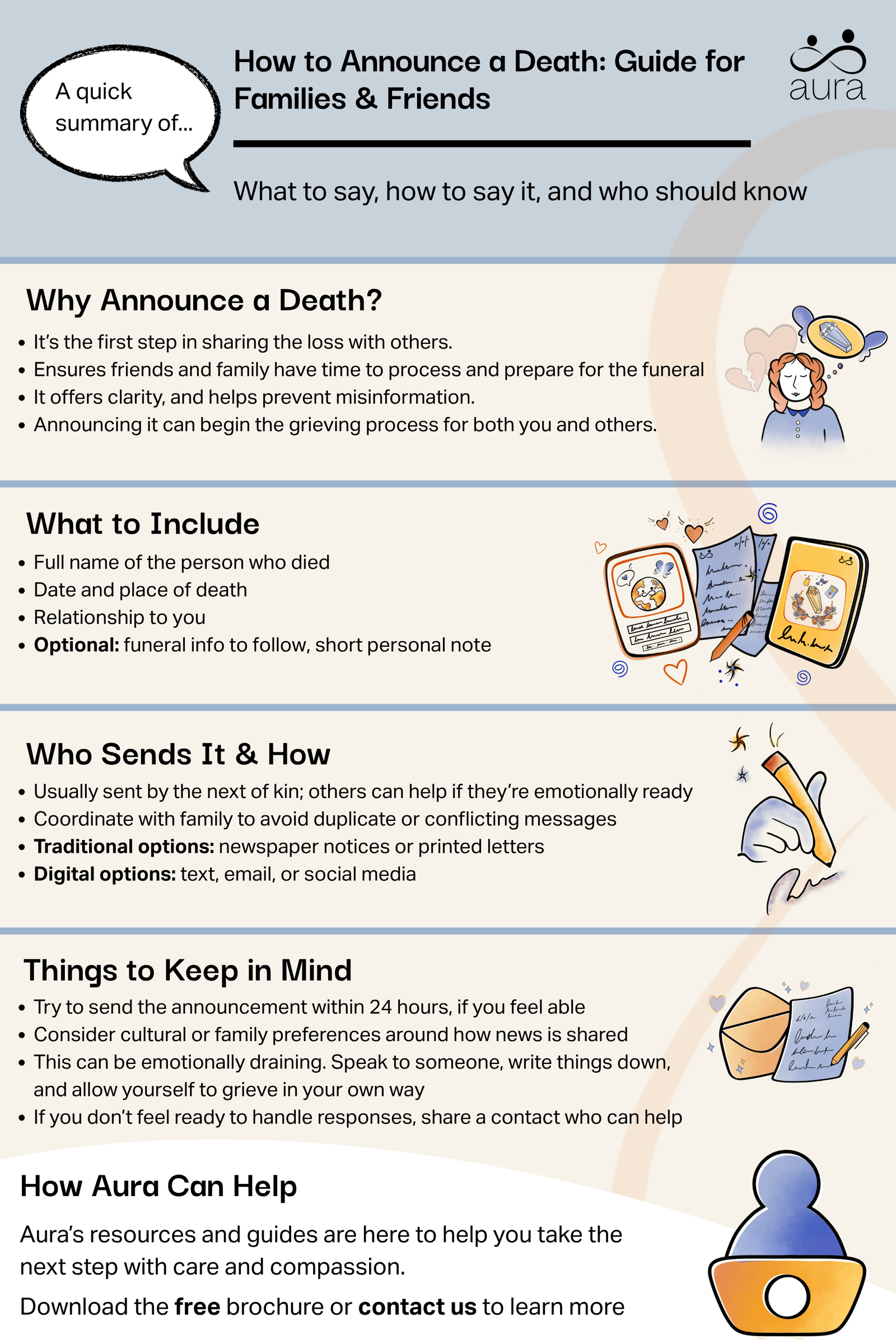


Written by Emily Cross.
19 minute read
The death of someone you love may bring to the surface a complex range of emotions that can be hard to process. Shock, disbelief, and even anger can all appear and leave you wondering how you will continue. Potentially one of the more challenging things to do is announce the death of your loved one to the people in your life.
We completely understand that this may be a time when the last thing you want to have to do is take action and reach out, but we also know that doing so may be the first of many steps in the grieving process. It can be difficult to know how to approach it in a way that’s kind and compassionate to those you’re reaching out to, while still giving yourself the time and space to sort through your own emotions.
In our experience as a team that delivers direct cremation services to families across the UK, dealing with grief and death can be a long and personal process. Our goal here is to provide you with some ideas, guidance, and comfort when it’s time to announce the death of a loved one.
We sincerely hope that you will be able to find an approach that you feel comfortable with and that allows you to reach out to the other people in your life.
Key takeaways:

A death announcement is typically a short notice of just a few lines of text that is sent to relatives, friends, and wider acquaintances within 24 hours of the death. It differs from an obituary, which is typically longer, includes context about the person’s life, and is often published in public forums such as newspapers and online noticeboards. The idea of an obituary is to begin commemorating the life of the person who has died, whereas the death announcement is more focused on informing people of the death for the first time.
While we have the right to announce the death of someone close to us, it is typically left to the next of kin to make the announcement first. Doing so in a way that combines clarity and respect is important, as reading the announcement will often be the way that many people who knew the person learn of their death.
As such, the death announcement will typically include the name, age, and place of death. If the death announcement is posted online, you may wish to edit it at a later date to include details of the funeral announcement once the arrangements have been made.
In the following sections we will provide guidance and advice we think you may find helpful. We have also created a guide that covers how to announce a death to friends if you would like some input regarding timings and the choice of words to use.
Knowing what to do when someone dies at home may be confusing or overwhelming, especially if the death was sudden and unexpected. Some people may feel like they are frozen and unable to function, but it’s important to remember that other members of the family and close friends have a right to know about the death too. In fact, finding the emotional energy to make the initial announcement may allow you to open up and take the first step in the grieving process rather than feeling like you are alone.
The name of the person who has died and the date of their death are the key details to include here, but breaking the news in a kind and compassionate way may require a few additions:
These thoughtful touches can help the message feel personal and considered, while giving the recipient the information they’ll likely want to know.
Although everyone grieves in their own way, our experience has been that focusing on factual accuracy in terms of the initial death announcement may help. There is plenty of time afterward for emotional expression and extended dialogue, but you may find that sending a lengthy piece of text could overwhelm some of the recipients. Even though you may well still be in a state of profound shock, remembering that reading your message is the first the recipients will have known about the death of your loved one can help provide a little perspective.
A death announcement will typically only consist of a few short and concise factual lines of text. A warm opening that expresses sadness may be able to soften things slightly, while the middle of the message will be devoted to key details such as the location of the death and the age of the person who has died.
Because death announcements are typically sent within 24 hours of the death, it is perfectly understandable if no thought has been given to funeral arrangements or viewing the loved one if circumstances permit. A closing line where you emphasise that you will be in touch regarding these matters in due course will be appreciated by all those who read your message. Adding such a line may also mean that you don’t have to field calls and messages asking about these arrangements when you wish to have some time to yourself.

Figuring out how to break bad news is something that many of us may not have thought of before, but there are typical approaches and social conventions that may prove helpful. We have also created a thoughtful guide that covers what to do when someone dies that may help you move forward once you have made the initial announcement. Some find that keeping busy provides a welcome distraction at what may be a very difficult time.
Newspaper notices, printed announcements, or posted letters are all traditional ways to announce the death of a friend, partner, or loved one when you have been tasked with doing so. Even if you are not the next of kin, you may have been asked by the next of kin to do so while they deal with the initial shock.
Printed death announcements, regardless of the specific location they are published, will typically be short, concise, and factual in nature. The idea is to raise awareness of the death as quickly as possible so that everyone finds out directly rather than hearing about the death secondhand from someone else.
Facebook, Whatsapp, email, and text messages are all viable options when you want to be able to quickly share a death announcement with a wide array of people. Despite emojis and graphics being commonplace on these types of platforms, you may decide that foregoing any such details is the best approach here. Replicating the same type of sombre traditional writing that you would find in a printed death announcement may help you strike the right balance so that you can communicate in a way that you feel is appropriate for the occasion.
Facebook and other social media platforms can be tools for informing wider social networks that include friends who have not been in close contact for a while, colleagues, and friends of friends. Taking the time to send a Facebook death announcement will allow you to make sure that everyone who may wish to attend the funeral or convey their best wishes is able to do so.
Setting your message so that it is publicly viewable is important as it will ensure that everyone is able to read it. Sometimes the death announcement is made on the page of the person who has died, while others prefer to post in communal groups such as school reunion pages and community pages. Setting the post so that people can leave a response may also help you as it will allow you to read comforting messages at a time when it can help to know that you are not alone.
Just as knowing how to plan a funeral is often a matter of timing and passing on information, so too is sending out the initial death announcement. Where possible, the death announcement is typically sent within 24 hours, although there are certainly times when this is not going to be practical. The very nature of death, particularly a sudden or unexpected death of a loved one, means that the sense of loss can put us into a deep state of shock that makes nothing else feel real in the hours and days immediately afterward.
If you feel that you are not emotionally ready to reach out, but feel strongly that others should know without delay, nominating a close friend or relative to do so may help. With your blessing, they could then call a list of immediate relatives and close friends, asking each of them to pass on the message where they can.
As hard as these moments are, making that first call to someone you trust can lift an enormous weight. You won’t be carrying the loss alone anymore—you’ll have someone who knew them too, someone you can message or speak with if it all feels too much.
The next of kin will generally be the person who takes responsibility for sending the announcement and others in the family will defer to them to avoid crossing a boundary. That said, if you can see the next of kin is struggling and you are already aware of the death, you may wish to reach out to them and offer to help. Likewise, if you are the next of kin and don’t feel emotionally ready, calling one or two close relatives or trusted friends and asking them to pass on the message may help.
If you are asked to distribute the announcement on behalf of the next of kin via phone and message, you may want to open with a line that lets the recipient know you are talking on behalf of the next of kin. Once they know you have their blessing, they will be more likely to engage with and accept what you are saying. Trying to avoid too much emotional sentiment while at the same time being calm and respectful may be a difficult balance to strike, but it is what will make your message that little bit easier on those who hear it.
There may also be a need to contact the employer of the person who has died so that they can take any internal steps they need regarding contracts, wages, etc. The key here is to ask to speak to a trained member of the HR team who will be well-versed in dealing with such sensitive matters. Although a call to work may not be at the top of your priorities, it may avoid potentially upsetting exchanges where messages are left asking where your loved one is.
If you ask the HR department to pass on the announcement to all those who need to know within the company, they will be able to do so in a way that is both appropriate and informative. Some families may request to be copied into any message that is sent, while others will prefer to leave everything up to the relevant company contact. Including a note about how any wellwishers can make contact with the family should they wish, and highlighting that funeral details will follow, could be something you wish to consider.
There are also some practical aspects that may need to be taken into account on a case-by-case basis. For example, if a loved one had been reported missing and initial signs are that they have been found but not formally identified, you may choose to delay the announcement until formal verification has taken place. Another example would be if you know that members of the extended family would find it culturally insensitive to read about the death of their relative online and would much rather receive a call or speak with you in person.
If you’re in the difficult position of not yet being certain that your loved one has died, it’s natural to want to keep others informed—just be mindful that sharing too soon may unintentionally lead to confusion or false hope. In the case where formal identification may take an extended period of time, you may wish to make calls to several close family members and let them know the situation. They can then use their best judgement when talking to other family members.
Because reading a death announcement triggers the initial sense of loss, it needs to do so much more than simply provide information. A carefully worded, respectful announcement may help those who receive it begin to navigate the five stages of grief in a way that makes them feel respected and cared for. With this in mind, here are some key points you may wish to make yourself aware of:
Being clear about the fact that further information regarding funeral arrangements or a memorial service will follow may help you avoid fielding a large number of calls in the coming days. You may also wish to leave the contact details of a friend or relative who is there to answer any initial queries if you don’t want to be contacted yourself. They could then help give you the time and space you need to start processing the death of your loved one while still making sure that everyone else can find the answers they need.
While much of this guide has focused on practical matters and considering the needs of others, it’s also important to think about your own feelings. Knowing how to cope with the suicide of a loved one, for example, can be particularly challenging as it may create feelings of abandonment or helplessness alongside other more common feelings of grief.
Taking a moment to check in with yourself and think about how you can recognise how you are feeling may help you sustain your emotional energy at this time. Others find that considering one or all of the following can help:
We each process death in our own way, so being kind to yourself if you don’t naturally gravitate toward one of these options is a healthy approach to take.
After sharing the news, you might find yourself wondering what to do next, or feel the urge to keep busy, just to keep going. If this is the case, our funeral checklist may provide some helpful direction that allows you to move forward in a way that empowers you to feel productive and useful. Many people report a feeling that they have lost their purpose when someone they love has died, in which case involving yourself in the funeral arrangements as a next step may prove helpful.
As a family-run funeral provider focused on helping in any way we can, our goal is always to offer support and guidance that goes far beyond our core services. With this in mind, we hope that you have found a way forward in our words above and that by taking this path you will be able to begin your grieving journey.
The death of someone you love may also give rise to a period of deep personal reflection where you think about your own life and the legacy you intend to leave behind. If you find that you want to think more deeply about how to get your own affairs in order, you may wish to consider services such as our prepaid funeral plans. When you feel emotionally ready to have the conversation, our team is always right here when you need us.
Terms and conditions apply, you will receive a funeral plan summary before purchase.

Our brochure includes all the details you need surrounding our prepaid direct cremation funeral plans.
Get your free brochure sent by email or First Class post by clicking on the link below.
Death announcements are not typically sent out until the close family has been informed. Siblings, children, parents, and anyone else you know who is very close to the person who has died will generally be told in person or over the phone. Doing so can understandably feel daunting or overwhelming, but it is also a key part of coming to terms with what has happened. You may find that making these calls gives you a chance to begin processing your own emotions.
A traditional death announcement focuses on factual details such as the name, age, and location of the death of the person who has died. Keeping the language formal, concise, and respectful can allow you to provide a heartfelt yet precise message at what is likely a difficult time. More emotional tributes will generally follow later.
Social media has changed the way many of us communicate, with more and more people using it as a forum to share everything in their lives. One of the issues that this may create is that some still feel that a Facebook death announcement is too impersonal or casual when breaking the news to close family and friends. That said, the decision ultimately lies with the next of kin and what they know about their individual family dynamics and friendship groups.
Convention dictates that the next of kin contacts the closest relatives and friends with a phone call or meets them in person where possible. This is something that may feel overwhelming if you are still in a state of shock, but it can also provide you with the feeling that you have a support network and that you are not alone. Once you have contacted everyone you feel you should talk to personally, a death announcement is typically made to inform the wider circle.
A death announcement will include the name, age, and location of the death of the person who has died as well as a note that funeral arrangements will follow. If the death announcement has been delayed to the point where the arrangements have already been made, they will usually be added at the end. Some next of kin also request that any queries be directed towards another relative or close friend during the days after the death if they feel they need time and space.
The tone is important because it will dictate the way that many people learn of the death of someone in their lives. A formal, sombre, and respectful tone that focuses on conveying the facts is what may be appropriate here. If you are unsure about the specific choice of wording, you may wish to ask a friend who is already aware of the death to help you write it.
An email or text is acceptable, but you may wish to consider which people would appreciate a call or visit in person. The point here is that you will know what is appropriate in each case given your relationships with each person. Sometimes it can help to create a list of people you want to contact and then sit with it for an afternoon before making the calls. Taking your time and working through it one by one will ensure that you don’t hurt anyone’s feelings by sending them an email when a call may have been deemed more considerate.
staging site last replicated: MISSINGNO.